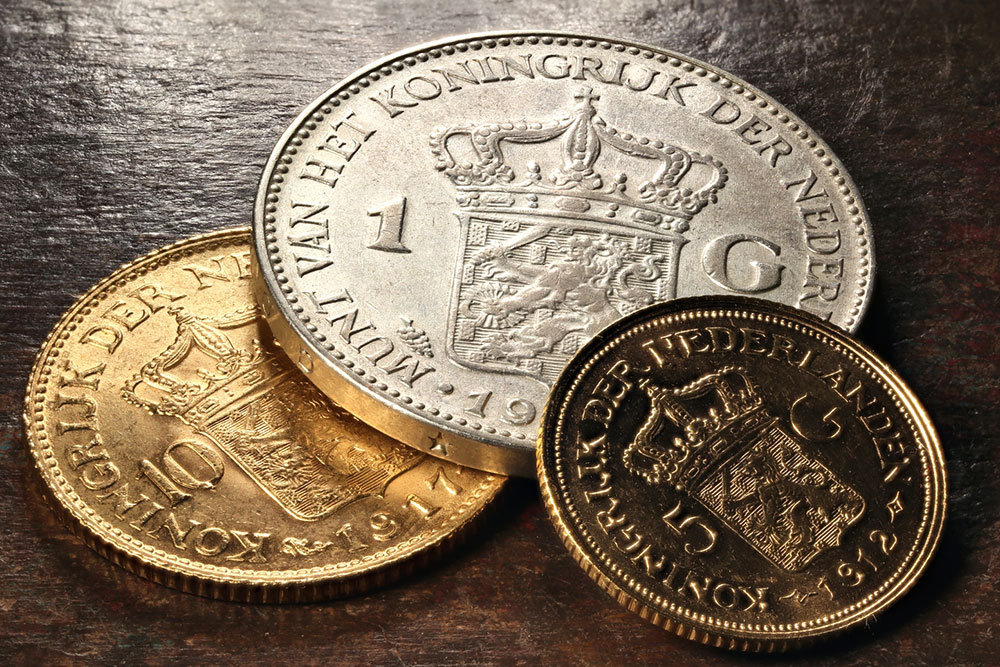6 Valuable Dutch Coins and Tips to Buy Them
Collecting precious coins has been a common interest among many for ages. Such coins are valuable not only for their visual appeal and uniqueness but also for their rich histories and depictions. And Dutch coins are full of enchanting historical backgrounds and cultural significance. If one buys and trades Dutch coins wisely, they can be worth a fortune. Also, unlike earlier times, today, vendors and buyers can conveniently carry out exchanges of these coins online.
1793 10 Stuivers Silver Coin
The rear side of this 18th-century Dutch coin from Utrecht features a Dutch virgin leaning against a column, sporting a liberty cap and carrying a spear.

½ Gulden Batavian Republic coin, 1802
This rare Gulden (Gold) coin from the Batavian Republic in the Netherlands East Indies depicts a VOC ship at sea. The coin dates back to the late 18th and early 19th centuries when the republic was newly established, and ½ Gulden Batavian Republic coins were in circulation.
Batavia ½ Duit 1808
The Batavia ½ Duit coin was in circulation from 1802 to 1809 during the Batavian Republic period.
10 Stuivers – Louis Napoleon
Circulated from 1807 to 1809, this coin features a right-side profile of King Louis Napoleon Bonaparte and Latin script minted on the obverse side. The 10 Stuivers – Louis Napoleon coin was engraved by Johann Georg Holtzhey, an 18th-century Dutch medallist and mint master.
Silver Ducat – Batavian Republic
This reeded-edge coin had different versions in the Batavian Republic time – Zeeland (1795-1798), West Friesland (1795-1796), Utrecht (1795-1805), etc. The coin’s rarity makes it a prized possession. Its front side features an armoured knight in a standing position, holding a sword upright on his right shoulder and carrying a ribbon in his left hand. This side also includes crowned Overijssel arms. The reverse side of the coin has crowned arms that divide the date and script in Latin, which translates to “With harmony, small things grow.” This visually appealing and intriguing coin from Dutch history is sure to enhance one’s coin collection.
2½ Gulden – Louis Napoleon
This unique, rare coin features the side profile of King Louis Napoleon Bonaparte on the obverse side and a crowned coat of arms of the kingdom of Holland, dividing the date and value on the reverse side. Considered a royal Dutch mint, it was in circulation in 1807. This milled bronze coin dates back to an integral era in Dutch history and is priceless for collectors.
Tips to buy rare Dutch coins
Start small
When pursuing a hobby such as coin collection, being hasty can lead to bad decisions and an inadequate collection. It helps to be patient and persevering, starting small and taking one step at a time to build one’s collection gradually and include only valuable, significant coins.
Attend coin expos and auctions
One of the best ways to find rare Dutch coins is to attend coin expos and exhibitions, which usually offer some of the rarest and most unique mints. When looking for rare Dutch coins, one should contact the exhibition organizer to check whether Dutch coins are being displayed and auctioned.
Network with other numismatists
The more one networks, the wider one’s reach will be. So, numismatists should interact with like-minded people, discussing ways and venues to collect rare and unique Dutch coins. Having the right contacts can help one secure valuable Dutch coins at the best value at exhibitions, auctions, etc.
Don’t overlook profitability
While coin collection is simply a hobby for most numismatists, it may also turn out to be highly profitable, especially if one is willing to trade rare Dutch coins. There are several Dutch coins from the Batavian era or prior to it, which are extremely rare, making them highly valuable. One should look out for such coins with high returns on online as well as offline platforms, not only with an aim to expand one’s collection but also to potentially earn profits and accumulate wealth. Moreover, when trading rare coins, it helps to look for places to sell old coins nearby.
Research well
Whether one procures old coins through offline modes or online platforms, research is imperative. It should be holistic, involving a historical and cultural overview of the coin, its current value, rarity, and profitability. When buying rare Dutch coins online, one should check out pictures of coins worth money and check the genuineness of the seller.
Set a budget
Increasing one’s coin collection with rare Dutch coins can be an interesting activity, but without a proper budget, one might end up in a financial crunch. So, it’s important to set a budget range for buying Dutch coins and decide the approximate profit percentage one would like to set when selling them.
